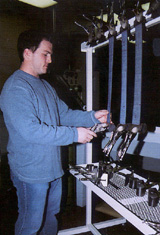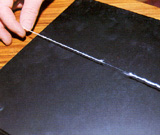By John Johnson
A new trend in denim apparel has emerged, and PCCA’s Textile Division is poised to seize the opportunity it presents. Based on initial reactions from customers, stretch denim products could add important earnings to the division’s financial statement.
Stretch denim apparel is not new to the marketplace, but in the past two years demand in the United States has increased significantly. On the other hand, apparel made from stretch denim has been a basic item in Asia for many years. Consequently, Asian textile manufacturers have been the primary supplier to apparel retailers and wholesalers (manufacturers) throughout the world.

ACG Product Development Supervisor Ryan Lupton tests samples of stretch denim fabric.
“We produced a limited amount of stretch denim from 1998 to 2001, but it was unsuccessful,” says Jack Mathews, PCCA’s vice president of fabric sales marketing. “Heat is a normal part of the denim finishing process, but finishing stretch denim is a totally different animal because it is heat sensitive,” Mathews continues. “It is the most difficult denim fabric any mill will produce.” The three primary attributes that must be controlled are stretch, shrinkage level, and recovery.
PCCA discontinued its efforts to manufacture stretch denim in 2001 due to customer complaints about inconsistent shrinkage. By mid-2002, however, increasing demand for stretch denim became too much to ignore, and the Textile Division resurrected the program and began using an existing prep range at its New Braunfels plant to finish the fabric and set the shrinkage level.
“Our earlier efforts focused on manufacturing and finishing techniques used to make yarn-dyed stretch fabrics,” says Darryl Lindsey, PCCA’s vice president of operations. “This process was unsuccessful for denim, and we knew we had to try different methods,” he adds.
“We discovered the prep range gave us phenomenal and consistent physical properties in the fabric,” Mathews says. “All three attributes are maintained when we use that equipment for finishing the fabric. Our first significant adoption (purchase) came from Levi Strauss Signature Brand for women’s apparel beginning in mid-2003. They are very happy with the consistency and quality of our fabric; it’s much better than what they were using.” Since then, seven more customers have adopted PCCA’s stretch denim products.

Core-spun yarn contains spandex to provide elasticity.
“Until about two years ago, retailers were buying nearly all of their stretch denim jeans as full packages from Asia up to nine months in advance,” says Mathews. “Then, growing consumer demand made it difficult for them to manage their supplies, and the retailers realized they needed to supplement their orders by sourcing some of their stretch denim apparel in the United States to get the products on the store shelves faster,” he says.
“Our most recent adoptions have come from PacSun, currently one of the hottest retailers, Wrangler, Calvin Klein, Dillards, Limited Too, Rue 21 and American Eagle,” Mathews explains. “All of the adoptions are for women’s wear with the exception of Limited Too which is for children’s wear.”
To manufacture stretch denim, PCCA’s American Cotton Growers Denim Mill uses core-spun yarn containing spandex for the filling yarn to provide elasticity. It is woven with open-end spun yarn to produce denim fabric that is 98 percent cotton and 2 percent spandex in a variety of weaves and dye shades, according to Product Development Supervisor Ryan Lupton.
“The finishing process we have developed in New Braunfels results in more consistent shrinkage than what our competitors can produce,” says Lupton. “Our customers must be able to depend on consistent shrinkage when the fabric is cut and sewn. We now have 10 different styles of stretch denim we can show our customers and potential customers, and we are developing a stretch fabric that contains only 1 percent spandex to reduce our production costs while maintaining acceptable stretch properties,” Lupton continues.
“We’re excited about the potential impact our stretch denim fabrics can have on the Textile Division’s performance,” says Lindsey. “These value-added products are priced significantly higher than our basic denim products, and that is very important in today’s market. Our creative and persistent product development efforts could begin paying off in 2004, and we are on the verge of finalizing another stretch denim product that will be totally unique in this industry,” Lindsey concludes.


